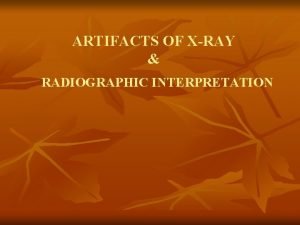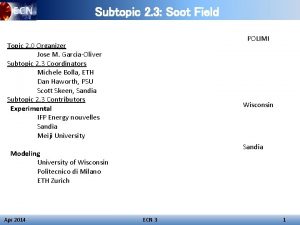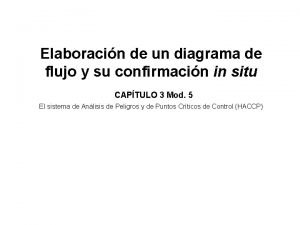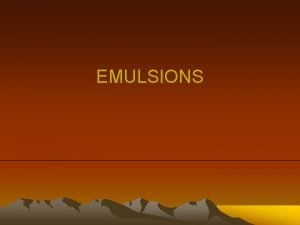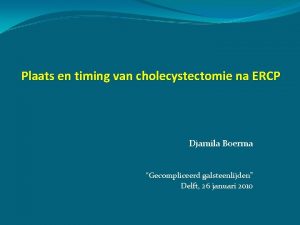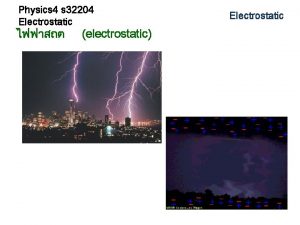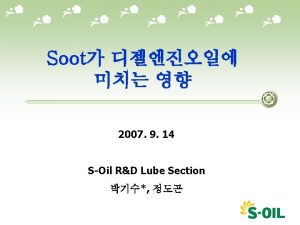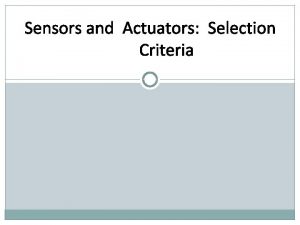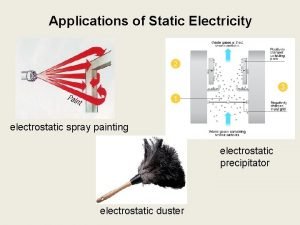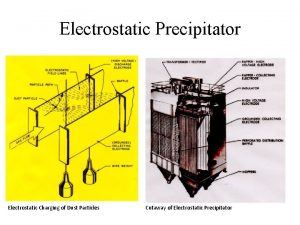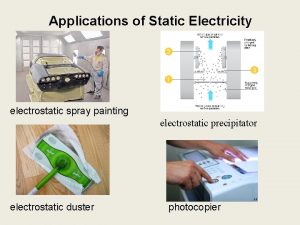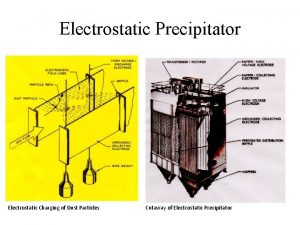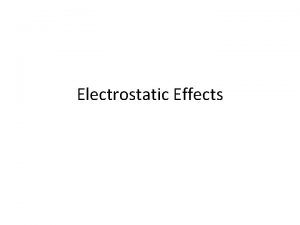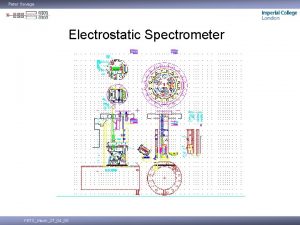Characterization of an In Situ Electrostatic Soot Sensor













- Slides: 13

Characterization of an In Situ Electrostatic Soot Sensor with Laboratory Measurement Instruments Jim Steppan 1, Brett Henderson, Anthoniraj Lourdhusamy, Victor Wang, Joe Fitzpatrick, Klaus Allmendinger Emi. Sense Technologies, LLC Matti Maricq, Dave Kubinski Ford Motor Company 1. Presenter UC Riverside Portable Emissions Measurement Systems Conference & Workshop, April 3 -4, 2014 1

Presentation Outline 1) 2) 3) 4) Introduction: PM OBD Requirements, PMTrac Theory of Operation Soot generator setup and results Engine dynamometer setup and results Summary UC Riverside Portable Emissions Measurement Systems Conference & Workshop, April 3 -4, 2014 2

Why A Real-Time PM Sensor is Needed for OBD Ø Demanding environmental emission legislation has created a need for robust PM sensors for OBD that are low-cost, sensitive, and accurate Ø EPA PM Emission Limits - Light-duty vehicles (chassis-certified): 0. 01 g/mi - Heavy-duty (HD) engines (engine-certified): 10 mg/bhp-hr (~2. 7 mg/m 3) Ø The HD OBD system 1 shall detect a malfunction prior to a decrease in the filtering capability of the PM filter (e. g. , cracking) that would cause an engine's PM emissions to exceed the following thresholds : - Pre 2013: 70 mg/bhp-hr (~19 mg/m 3) - 2013 – 2015: 50 mg/bhp-hr (~14 mg/m 3) - 2016 and future: 30 mg/bhp-hr (~8 mg/m 3) 1. http: //www. arb. ca. gov/regact/2009/hdobd 09/fro 19711. pdf ; page 48; downloaded 3/28/11 UC Riverside Portable Emissions Measurement Systems Conference & Workshop, April 3 -4, 2014 3

PM Sources and Characterization of PM Sensors Ø PM measurement and calibration of PM measurement instruments are more complex than other gaseous pollutants Ø Certified combustion gas mixtures are readily available for calibrating gas analyzers, but this is not the case for PM Ø Additional complexity for PM as the chemical composition, particle size distribution (PSD), and particle charge distribution (PCD) of PM varies with engine combustion and exhaust pipe conditions Ø Most commercially-available reference instruments can’t directly measure the high PM concentrations typical in the exhaust. A representative exhaust sample must be drawn and diluted Ø Dilution cause new particle nucleation and/or condensation of gaseous materials Ø There may be differences between in-situ and reference measurements UC Riverside Portable Emissions Measurement Systems Conference & Workshop, April 3 -4, 2014 4

PMTrac® PMB 2 Electrostatic Soot Sensor § Electrostatic measurement principle § In situ soot measurement with no dilution § High accuracy and outstanding correlation with AVL MSS § High resolution (detection limit < 0. 25 mg/m 3) § Fast (real-time) transient response § Wide measurement range (0 to 630 mg/m 3) § Simple, robust, and cost-effective design and construction § Suitable for OBD sensor for DPF failure detection UC Riverside Portable Emissions Measurement Systems Conference & Workshop, April 3 -4, 2014 5

PMTrac Sensor Captures Charged Particles, Agglomerates, and Amplifies Charge up to ~1000 Times • • Venturi draws exhaust gas through sensor Concentric electrode configuration similar to DMA Gas flows through electric field between electrode (+) and inner baffle (-); field strength ~800 k. V/m Naturally-charged, combustion-generated particles captured Captured particles assemble (agglomerate) via electrostatic force-directed assembly (ESFDA) into filamentous structures with high surface charge density at filament tips At growth limit of surface charge density newly captured particles or part of filaments break off and transition to opposite polarity electrode, carrying surface area proportional charge Process repeats at opposite electrode Result is a ~3 orders of magnitude charge current amplification 2 -5 micron agglomerates evident on HV electrode at later stages and exiting sensor via SMPS and APS UC Riverside Portable Emissions Measurement Systems Conference & Workshop, April 3 -4, 2014 6

PMTrac Sensor Response (n. A) is Proportional to Mass • Diesel particle mass 1 -4 follows a Dp 2. 33 power law in particle diameter (Dp) • PMTrac sensor output (n. A) shows a Dp 2. 37 power law response • PMTrac sensor response (n. A) is proportional to particle mass for “typical” diesel combustiongenerated particles Calculation Experiment 1) Visser et al, A Potential Soot Mass Determination Method from Resistivity Measurement of Thermophoretically Deposited Soot, Aerosol Science 45: 2, 284 -294, fit to table 3 data 2) Maricq et al, The effective density and fractal dimension of soot particles from premixed flames and motor vehicle exhaust, Aerosol Science 35 (2004) 1251 – 1274 3) D. B. Kittelson et al, Structural Properties of Diesel Exhaust Particles Measured by Transmission Electron Microscopy (TEM): Relationships to Particle Mass and Mobility, Aerosol Science and Technology, 38: 881– 889, 2004 4) J. Riessler et al, Mass-mobility relationship of soot generator and diesel soot, European Aerosol Conference 2009, Karlsruhe UC Riverside Portable Emissions Measurement Systems Conference & Workshop, April 3 -4, 2014 7

Multi-Sensor Characterization Test Rig: P&ID • • Designed, built, and demonstrated multi-sensor test rig for characterizing sensors at Ford Jing Mini-CAST 1 soot generator with Dekati FPS-4000 diluter AVL MSS TSI Dusttrak Constant EGT = 24 o. C 0. 5, 1, 2 LPM sample flow rates EGV ~ 14, 30, 70 m/s UC Riverside Portable Emissions Measurement Systems Conference & Workshop, April 3 -4, 2014 8 8

PMTrac Sensor Demonstrates Good Linearity with PM Concentration at Constant EGV and EGT Mean of 21 Sensors 4. 32 +/- 0. 36 n. A/(mg/m 3) Jing Mini-CAST 1 Constant EGT = 24 o. C 1 LPM sample flow Constant EGV ~ 30 m/s 1 each PMTrac Sensor UC Riverside Portable Emissions Measurement Systems Conference & Workshop, April 3 -4, 2014 9

PMTrac Sensor Demonstrates Repeatable Flow Response at Constant EGT for A Wide PM Range EGV~ 30 m/s EGV~ 70 m/s EGV~ 14 m/s Jing Mini-CAST 1 Constant EGT = 24 o. C 1. 7 < PM (mg/m 3) < 15 UC Riverside Portable Emissions Measurement Systems Conference & Workshop, April 3 -4, 2014 10

PMTrac Sensor Testing on Ford RIC 9 Dynamometer UC Riverside Portable Emissions Measurement Systems Conference & Workshop, April 3 -4, 2014 11

PMTrac Sensor SS T-Corrected Example Ford RIC 9 Engine Dynamometer Test Results All steady-state data (9/20/2013 – 12/06/2013), 275 runs • Avg. sensor current for entire steady-state run vs. avg. m. SS reading. • Similar EGT-corrected sensitivities (16. 3 +/- 0. 6 n. A/(mg/m 3)) for all sensors • Sensors can measure <0. 25 mg/m 3 • Positive x-axis offset for all sensors UC Riverside Portable Emissions Measurement Systems Conference & Workshop, April 3 -4, 2014 12

Summary and Future Efforts • • Emi. Sense PMTrac sensor is an in-situ, real-time PM sensor that correlates well with the AVL MSS over a wide range of SS test conditions and different soot sources 30 < EGT (o. C) < 340 10 < EGV (m/s) < 60 1 < PM (mg/m 3) < 15 PMTrac sensitivity (n. A/(mg/m 3)) is consistent for a given soot source and exhaust configuration PMTrac sensor appears relatively insensitive to EGV and EGT PMTrac sensor measures charged particles, but not neutral particles SMPS, APS, and SEM results confirm that larger (0. 4 to 10 um) break-off agglomerates exit the sensor, verifying ESFDA PMTrac sensor signal (n. A) is amplified several orders of magnitude higher than if the observed current were solely caused by combustion-generated charged particles Transient analyses for FTP, NRTC, and LA 92 underway First-principles-based model and transfer function that converts the PMTrac sensor’s signal (n. A) to soot mass concentration (mg/m 3) as a function of EGT, EGV, soot characteristics, and sensor characteristics is being developed UC Riverside Portable Emissions Measurement Systems Conference & Workshop, April 3 -4, 2014 13
 Soot and whitewash radiography
Soot and whitewash radiography Wilbur soot quotes
Wilbur soot quotes 3 soot in mm
3 soot in mm Indirect and direct characterization
Indirect and direct characterization What is indirect and direct characterization
What is indirect and direct characterization Dry gum method
Dry gum method Cancer in situ
Cancer in situ Meaning of biodiversity conservation
Meaning of biodiversity conservation Griffin ford model example city
Griffin ford model example city Carcinoma in situ
Carcinoma in situ Confirmación in situ del diagrama de flujo
Confirmación in situ del diagrama de flujo Difference between dry gum method and wet gum method
Difference between dry gum method and wet gum method Cholecystectomie na pancreatitis
Cholecystectomie na pancreatitis Pengurusan situ
Pengurusan situ
